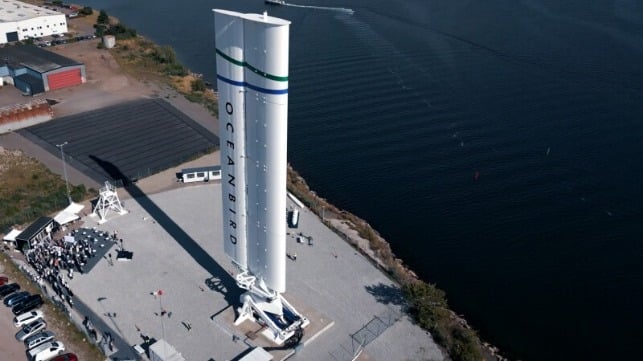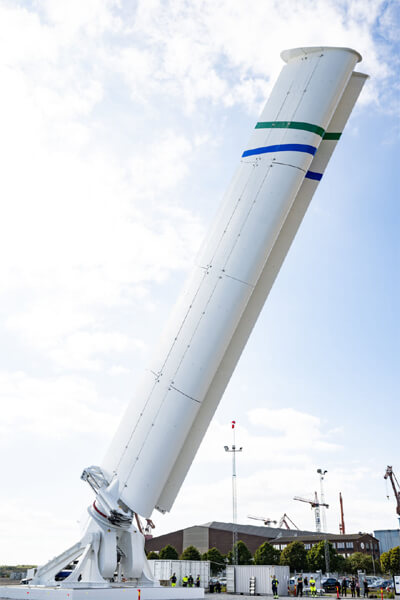Oceanbird Wing Sail Reaches for the Sky in Demonstration

After more than three years of planning and research, Oceanbird unveiled its first prototype wing sail as the latest entry into the wind-assisted propulsion market. At an event in Sweden on August 25, the company said it is entering a new phase as it moves to commercial application, which will see the first sail installed aboard a vessel I 2026.
Oceanbird, the company, was launched in 2021 as a partnership between Sweden’s Wallenius Lines and Alfa Laval with the mission of developing the concept for commercial application. Wallenius first previewed its concept of a sail-powered car carrier in 2020. A Swedish R&D project team, consisting of Wallenius Marine, KTH Royal Institute of Technology, and SSPA/RISE, and supported by Swedish Transport Administration, spent over three years refining the design, while the company also worked on the business concepts.
“We believe that wind propulsion can grow into a significant new industry for Sweden — one that brings together engineering, sustainability, and maritime leadership,” said Magnus MackAldener, interim CEO & Head of R&D at Oceanbird, who moderated the inauguration. With the sail cutting the ribbon as it rose, MackAldener said they were ready to show it to the world and take orders.
The prototype is installed at the Orsesund DryDocks in Landskrona, Sweden. It stands 40 meters (131 feet) and is 14 meters (46 feet) wide. It rose from the lowered position, unfolded its two segments, and demonstrated a full rotation. Oceanbird has installed a full control room at the yard for demonstrations and crew training.
The sail has a high-strength steel core. The aerodynamic surface is a composite of glass fiber, and it is made from 370,000 recycled plastic bottles. They are calling it Wing 560.
“We need pioneers who are willing to take risks, to innovate, and to lead the way into the green industrial transformation, and this is a great example of leadership. Oceanbird stands as proof of this success,” said Andreas Carlson, Sweden's Minister of Infrastructure and Housing at the inauguration.

During the event, the sail was raised and unfurled and demonstrated its rotation (Oceanbird)
The company highlights that it has undertaken extensive data simulations as well as physical tests. It conducted wind tunnel and model tests in open water and water tanks. It has also undertaken Lidar measurements. They report that a single wing can reduce fuel consumption and emissions by 10 percent, and with the full installation, it will be possible to achieve up to a 90 percent reduction in emissions if all the factors are aligned.
The next step is the assembly of a second, identical wing sail, which will be completed this fall at the yard. It will be installed on the Wallenius Wilhelmsen vessel Tirranna at the beginning of 2026. Built in 2009, the 30,000 dwt vessel with a capacity of 7,620 cars was fitted in July 2024 with the foundation for the wing sail. Preparations have been completed, and they will begin tests aboard the operational vessel.
The tests come as wind-assisted propulsion continues to generate interest in the industry. Several concepts of rigid sails and wind rotors are being installed in an increasing number of commercial vessels. Operations have confirmed the expected fuel savings on vessels ranging from tankers to bulkers and RoRos.
